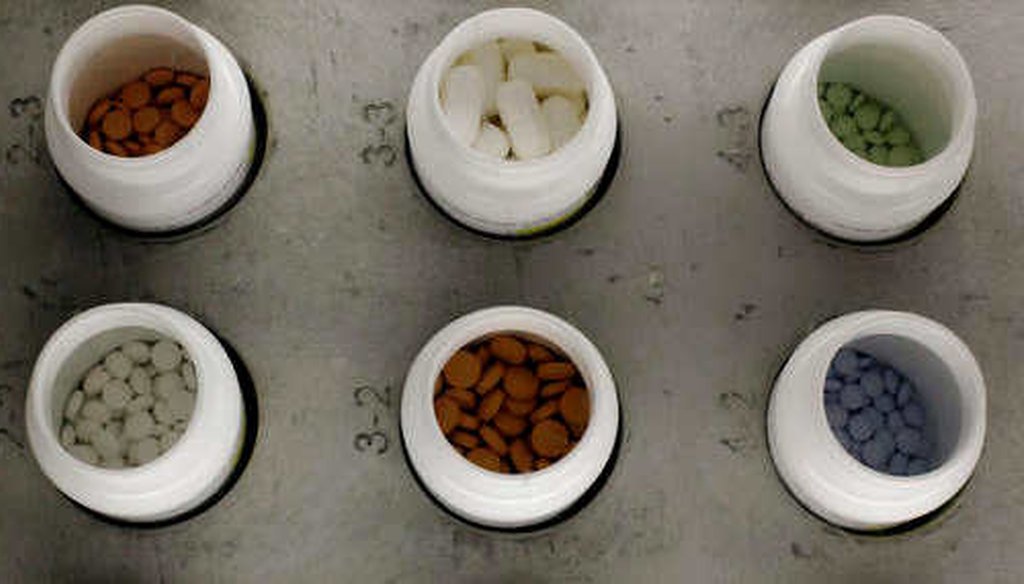

Our only agenda is to publish the truth so you can be an informed participant in democracy.
We need your help.


Prescription drugs at a hospital dispensary. (AP)
Research cited by Baldwin’s office doesn’t account for generic drugs, and that figure doesn’t apply to every prescription analyzed.
But experts say brand-name drug prices have outpaced inflation for years and account for most of the spending on prescriptions.
U.S. Sen. Tammy Baldwin is revisiting a problem she’s fought against more than once during her time in office: high drug prices.
The Wisconsin Democrat — joined by colleagues on both sides of the aisle — reintroduced legislation on March 23, 2021 that would require manufacturers to disclose and justify their decisions to increase prescription drug costs. Baldwin previously co-sponsored the bill with the late U.S. Sen. John McCain and highlighted it during her 2018 reelection bid.
The latest announcement from Baldwin and U.S. Sens. Mike Braun, R-Indiana, Tina Smith, D-Minnesota, and Lisa Murkowski, R-Alaska, painted an urgent picture of "skyrocketing" prices and argued the bill would ensure transparency for taxpayers.
"Over the past decade, drug prices have risen at three times the rate of inflation," the news release stated.
Does this claim add up?
When asked for evidence to support the statement, Baldwin’s office pointed to two studies that analyzed the relationship between drug prices and inflation.
A study published in March 2020 looked at the prices of branded medications from 2007 to 2018 and found list prices increased by 159% over that time period and 9.1% per year. Researchers also determined that the drugs’ net prices — adjusted for discounts and rebates — increased 60%, or an average of 4.5% per year.
That was 3.5 times faster than the inflation rate, the study noted, which lines up with the figure Baldwin cited. But researchers didn’t touch on generic drugs, which make up the lion’s share of the market — some 90% of prescriptions.
That said, despite accounting for just 10% of all prescriptions, brand-name drugs make up about 75% of all drug spending, according to recent congressional testimony from Aaron Kesselheim, a professor of medicine at Harvard Medical School.
The same is true within the Medicaid program. According to a 2019 analysis from the Medicaid and CHIP Payment and Access Commission, spending on brand-name drugs increased from 76.6% to 80.5% from 2014 to 2017 even though generics exceeded 80% of all drug claims.
"There are a lot of essential medicines that are still available only in brand names," Kesselheim told PolitiFact Wisconsin.
Another analysis cited by Baldwin’s office from the Kaiser Family Foundation looked at changes in pricing for both brand-name and generic drugs in a single year.
According to that study, the prices of half of all drugs covered under Medicare Part D — which amounts to more than 1,600 medications — increased more than the rate of inflation from July 2018 to July 2019. The median price hike among those drugs was 6.4% — more than 3 times the inflation rate of 1.8% that year.
Researchers also determined that 45 medications used by more than 1 million enrollees — including 38 generics — outpaced inflation with a median price increase of 5.7%.
So, that part of the study bolsters Baldwin’s claim.
But the Kaiser study also found the increase in cost of 419 drugs was below inflation, while another 1,241 saw price decreases. And since that study limited its timeframe to one year, it doesn’t speak to the decade-long trend Baldwin referenced.
In a news release, Baldwin and her Senate colleagues claimed "over the past decade, drug prices have risen at three times the rate of inflation."
One study that lines up with Baldwin’s claim doesn’t account for generic drugs, and the other only looks at one year of cost increases. But experts say brand-name drug prices in particular have outpaced inflation for years — some at the rate Baldwin referenced — and account for most of the spending on prescriptions.
That leaves us with a statement that’s partially accurate but leaves out important details or takes things out of context.
That’s our definition for Half True.
U.S. Sen. Tammy Baldwin, The FAIR Drug Pricing Act, accessed March 29, 2021.
Milwaukee Journal Sentinel, Wisconsin U.S. Senate race: Tammy Baldwin's first ads focus on 'buy America' and prescription drug prices, Feb. 26, 2018.
Email from U.S. Sen. Tammy Baldwin’s office, March 25, 2021.
Journal of the American Medical Association, Changes in List Prices, Net Prices, and Discounts for Branded Drugs in the US, 2007-2018, March 3, 2020.
Kaiser Family Foundation, Price Increases Continue to Outpace Inflation for Many Medicare Part D Drugs, Feb. 4, 2021.
Emails from Inmaculada Hernandez, assistant professor and associate director for the Center for Pharmaceutical Policy and Prescribing at the University of Pittsburgh, March 29-30, 2021.
Interview with Rachel Sachs, associate professor of law at Washington University in St. Louis, April 2, 2021.
Medicaid and CHIP Payment and Access Commission, Medicaid Drug Spending Trends, accessed April 5, 2021.
Interview with Aaron Kesselheim, professor of medicine at Harvard Medical School, April 5, 2021.
Testimony of Aaron Kesselheim before the U.S. Senate Committee on Health, Education, Labor, and Pensions, March 23, 2021.
In a world of wild talk and fake news, help us stand up for the facts.
